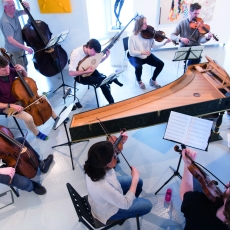Kate Lindsey, Arcangelo & Jonathan Cohen - Tiranno - San Francisco Classical Voice
Mezzo–soprano Kate Lindsey is a force of nature. Seemingly unwilling to cede the crown of extreme characterization to fellow mezzo Cecilia Bartoli, she has seized upon the character of Nero (Nerone), the fifth emperor of Rome, as a supreme vehicle for her histrionic gifts. In Tiranno (Alpha 736), her second recorded recital with Jonathan Cohen’s early music ensemble Arcangelo, Lindsey explores how Alessandro Scarlatti (1660–1725), Handel (1685–1759), Monteverdi (1567–1643), and Bartolomeo Monari (1662–1697) depicted the tyrannical emperor and the not always lovely women in his immediate orb. As described by liner notes author James Halliday, these included “the incestuous, conniving Agrippina, the cruelly discarded Octavia, and the scheming, insatiable, and luxuriant Poppæa.”
Without attempting to separate fact from fiction — what matters most is the drama — each composer and librettist choses a different character or characters for his focus. In Il Nerone, one of Scarlatti’s 700+ chamber cantatas, the spotlight is on the emperor — he who sings “In my realm only cruelty reigns” in a voice that bespeaks delight rather than remorse. In the cantata Agrippina condotta a morire (Agrippina led to execution, 1707), Handel focuses on Nero’s mother, Agrippina, whom the emperor condemned to death. Monteverdi, who set Giovanni Francesco Busenello’s libretto in L’incoronazione di Poppea (The coronation of Poppea), ignores Agrippina entirely as he focuses on Poppæa, the by–any-means-necessary seductress who made her way into Nero’s bed, and everyone around her.
Tiranno ends with two world premiere recordings. In La Poppea (1685), the lesser-known Monari takes up Poppæa’s story where Monteverdi left off. Finally, in Scarlatti’s La Morte di Nerone (The death of Nero, 1690), it’s Nero’s turn to bid adieu via suicide at the not so tender age of 30.
As with all tales of soap-opera potential, a vocal artist basically has two ways forward; either they can opt for expressive restraint — think the alternative to Callas’s Tosca — or they can go the full-out, blood-and-guts route. Lindsey, as you can imagine from her 2015 San Francisco opera portrayal of Cherubino in The Marriage of Figaro, prefers to go far beyond the role of simple innocent.
Which does not mean that she cannot sing with restraint and beauty. Take, for example, her heavenly performance of “Pur ti miro! Pur ti godo!” (At last I see you! At last I enjoy you!) in which she joins soprano Nardus Williams for the third act finale of Moneteverdi’s opera.
Here, music and singing are so beautiful that one can easily overlook what is actually taking place. Below is one director’s take on the opera from Lindsey’s live performance with Les Arts Florissants under William Christie in which she duets sublimely with soprano Sonya Yoncheva. I find the production fascinating, and also appreciate Christie’s choice to start the music faster and then, after the middle section, slow down for the recapitulation. Nonetheless, I acknowledge that some readers may find themselves grateful for audio-only recordings.
Although I can’t find another video clip on YouTube, the entire excerpt from Monteverdi’s opera is striking for Lindsey’s ability to adopt a very different, virtually countertenor-like voice when the drama calls for such. This heightens the contrast with the sublime beauty of the final duet. For another example of her beautiful singing, sample the aria, “Veder chi pena” (To watch those that suffer and sigh) from Scarlatti’s Il Nerone. The long-breathed final phrase is a thing of wonder.
One cannot overpraise Lindsay’s ability to characterize strongly while retaining beauty of tone when the music calls for such. Note her ability, in Agrippina’s “Quella morte, che per gioco” (Death, which was once so ready to sport at my mere glance) invocation of suicide, to temper her voice down to a mere thread, and then end a long, straight-toned phrase with an almost breathtaking shimmer of vibrato. The manner in which she softens in the ensuing cavatina, “Il suo pensier l’uccida” (May his very through kill him, or his ghost, or his name) makes it impossible to ignore what Scarlatti is trying to say.
For lovers of vocal artistry, Tiranno is a must. Is it even necessary to say that, for maximum enjoyment, downloading or streaming the hi-resolution 24/96 files is the way to go?


